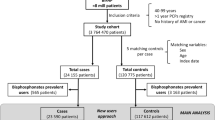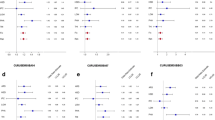Abstract
Osteoporosis is a major public health problem resulting in significant morbidity, mortality, and utilization of healthcare resources. Bisphosphonates are the most widely prescribed drugs for increasing bone mass and preventing osteoporosis-related fractures. Although these drugs have proven efficacy and are generally considered safe, a clinical trial of once-yearly zoledronic acid reported an unexpected increase in the risk of cardiac arrhythmias, primarily due to serious atrial fibrillation (AF). Subsequently, a post hoc analysis of another clinical trial reported a nonsignificant trend toward an increased risk of serious AF. Based on these concerns, the US FDA issued a cautionary advisory and is conducting an ongoing safety review.
A major limitation of the clinical trials was the fact that none were designed or powered to evaluate arrhythmia endpoints. In search of more definitive answers, several observational studies using both population-based cohort and case-control designs have attempted to verify this association. However, only two studies, one cohort and one case-control study, have found a positive association, while six additional studies have reported negative findings. While most of the observational studies attempted to control for confounders, the chosen variables have varied considerably, and other key potential confounders such as smoking were not controlled for in any of the studies.
Because the occurrence of AF events in the studies was relatively low, four meta-analyses have been conducted to increase sample size by using pooled data from multiple studies. Again, results have been inconsistent, with two of the analyses reporting a significant increase in serious AF and two finding no association.
Additionally, no direct evidence has identified any underlying mechanism to explain an increased arrhythmia risk with bisphosphonate therapy. However, several possible mechanisms have been proposed, including an activated inflammatory state, altered electrolytes impacting cardiac conduction, and long-term atrial structural changes.
Due to the widespread use of bisphosphonates in a population for whom the baseline risk of AF also increases with advancing age, further prospective assessment of this possible association is clearly warranted. If an association does exist between bisphosphonates and an increased risk for AF, several additional questions will need to be answered including impact of baseline risk, the time course for increased risk, relationship to drug dose, and whether or not this represents a drug-class adverse effect. Until definitive evidence is available, clinicians will continue to have to make clinical judgments based on the available and often inconsistent evidence to date. To provide further perspective on this possible association, we performed a systematic search of the PubMed database from 1966 to 30 June 2010, drug regulatory websites, and drug manufacturer websites. In this review we summarize the findings from clinical trials, observational studies, and meta-analyses evaluating the risk of AF following bisphosphonate exposure, and discuss possible mechanisms that could explain an increased risk.


Similar content being viewed by others
References
Owen G. An integrated approach: bisphosphonate management for the treatment of osteoporosis. Am J Manag Care 2007; 13: S290–308.
Cramer JA, Amonkar MM, Hebborn A, et al. Compliance and persistence with bisphosphonate dosing regimens among women with postmenopausal osteoporosis. Curr Med Res Opin 2005; 21: 1453–60.
Compston JE, Seeman E. Compliance with osteoporosis therapy is the weakest link. Lancet 2006; 368: 973–4.
Black DM, Delmas PD, Eastell R, et al., for the HORIZON Pivotal Fracture Trial. Once-yearly zoledronic acid for treatment of postmenopausal osteoporosis. N Engl J Med 2007; 356: 1809–22.
Cummings SR, Schwartz AV. Alendronate and atrial fibrillation (letter). N Engl J Med 2007; 356: 1895–6.
Early communication of an ongoing safety review on bisphosphonates: alendronate (Fosamax, Fosamax Plus D), etidronate (Didronel), ibandronate (Boniva), pamidronate (Aredia), risedronate (Actonel, Actonel W/Calcium), tiludronate (Skelid), and zoledronic acid (Reclast, Zometa). 1 Oct 2007 [online]. Available from URL: http://www.fda.gov/Safety/MedWatch/Safety Information/SafetyAlertsforHumanMedicalProducts/ucm150837.htm [Accessed 2009 Jun 17].
Update of safety review follow-up to the October 1, 2007 early communication about the ongoing safety review of bisphosphonates. 12 Nov 2008 [online]. Available from URL: http://www.fda.gov/Drugs/DrugSafety/Postmarket DrugSafetyInformationforPatientsandProviders/DrugSafetyInformationfor HeathcareProfessionals/ucm136201.htm [Accessed 2010 Apr 16].
Kara R, Camm J, McClung M. Yearly zoledronic acid in postmenopausal osteoporosis (letter). N Engl J Med 2007; 357: 712–3.
Lyles KW, Colon-Emeric CS, Magaziner JS, et al. Zoledronic acid and clinical fractures and mortality after hip fracture. N Engl J Med 2007; 357: 1799–809.
Abrahamsen B, Eiken P, Brixen K. Atrial fibrillation in fracture patients treated with an oral bisphosphonate. J Intern Med 2009; 265: 581–92.
Bunch TJ, Anderson JL, May HT, et al. Relation of bisphosphonate therapies and risks of developing atrial fibrillation. Am J Cardiol 2009; 103: 824–8.
Vestergaard P, Schwartz K, Pinholt E, et al. Risk of atrial fibrillation associated with use of bisphosphonates and other drugs against osteoporosis: a cohort study. Calcif Tissue Int 2010; 86: 335–42.
Huang W, Tsai Y, Wen Y, et al. Osteoporosis treatment and atrial fibrillation: alendronate versus raloxifene. Menopause 2010; 17: 57–63.
Sorensen HT, Christensen S, Mehnert F, et al. Use of bisphosphonates among women and risk of atrial fibrillation and flutter: population based case-control study. BMJ 2008; 336: 813–6.
Grosso A, Douglas I, Hingorani A, et al. Oral bisphosphonates and risk of atrial fibrillation and flutter in women: a self-controlled case-series safety analysis. PLoS ONE 2009; 4(3): e4720.
Heckbert SR, Li G, Cummings SR, et al. Use of alendronate and risk of incident atrial fibrillation in women. Arch Intern Med 2008; 168: 826–31.
Loke YK, Jeevanantham V, Singh S. Bisphosphonates and atrial fibrillation: systematic review and meta-analysis. Drug Saf 2009; 32: 219–28.
Bhuriya R, Singh M, Molnar J, et al. Bisphosphonate use in women and the risk of atrial fibrillation: a systematic review and meta-analysis. Int J Cardiol 2010 Jan. Epub ahead of print.
Kim SY, Kim MJ, Cadarette SM, et al. Bisphosphonates and risk of atrial fibrillation: a meta-analysis. Arthritis Res Ther 2010 Feb 19; 12: R30. Epub ahead of print.
Mak A, Cheung M, Ho R, et al. Bisphosphonates and atrial fibrillation: Bayesian meta-analyses of randomized controlled trials and observational studies. BMC Musculoskeletal Disorders 2009; 10: 113.
Aviles RJ, Martin DO, Apperson-Hansen C, et al. Inflammation as a risk factor for atrial fibrillation. Circulation 2003; 108: 3006–10.
Pazianas M, Compston J, Huang CL-H. Atrial fibrillation and bisphosphonate therapy. J Bone Min Res 2010; 25: 2–10.
Hewitt RE, Lissina A, Green AE, et al. The bisphosphonate acute phase response: rapid and copious production of proinflammatory cytokines by peripheral blood gammadelta T cells in response to aminobisphosphonates is inhibited by statin. Clin Exp Immunol 2005; 139: 101–11.
Van Wagoner DR, Nerbonne JM. Molecular basis of electrical remodeling in atrial fibrillation. J Mol Cell Cardiol 2000; 32: 1101–17.
Poole KE, Kaptoge S, Reeve J. Yearly zoledronic acid in postmenopausal osteoporosis (letter). N Engl J Med 2007; 357: 711–2.
Vasikaran SD. Bisphosphonates: an overview with special reference to alendronate. Ann Clin Biochem 2001; 38: 608–23.
Rosen CJ, Brown S. Severe hypocalcemia after intravenous bisphophonate therapy in occult vitamin D deficiency. N Engl J Med 2003; 348: 1503–4.
Poole KE, Loveridge N, Rose CM, et al. A single infusion of zoledronate prevents bone loss after stroke. Stroke 2007; 38: 1519–25.
Reid IR, Brown JP, Burckhardt P, et al. Intravenous zoledronic acid in postmenopausal women with low bone mineral density. N Engl J Med 2002; 346: 653–61.
Black D. Yearly zoledronic acid in postmenopausal osteoporosis (letter). N Engl J Med 2007; 357: 711–2. 714.
Singer DE, Albers GW, Dalen DE, et al. Antithrombotic therapy in atrial fibrillation. Chest 2008; 133: 546S–92S.
Majumdar SR. Oral bisphosphonates and atrial fibrillation (editorial). BMJ 2008; 336: 784–5.
Acknowledgments
There was no funding from any source provided for this work. The authors have no conflicts of interest that are relevant to the content of this review.
Author information
Authors and Affiliations
Corresponding author
Rights and permissions
About this article
Cite this article
Howard, P.A., Barnes, B.J., Vacek, J.L. et al. Impact of Bisphosphonates on the Risk of Atrial Fibrillation. Am J Cardiovasc Drugs 10, 359–367 (2010). https://doi.org/10.2165/11584720-000000000-00000
Published:
Issue Date:
DOI: https://doi.org/10.2165/11584720-000000000-00000




